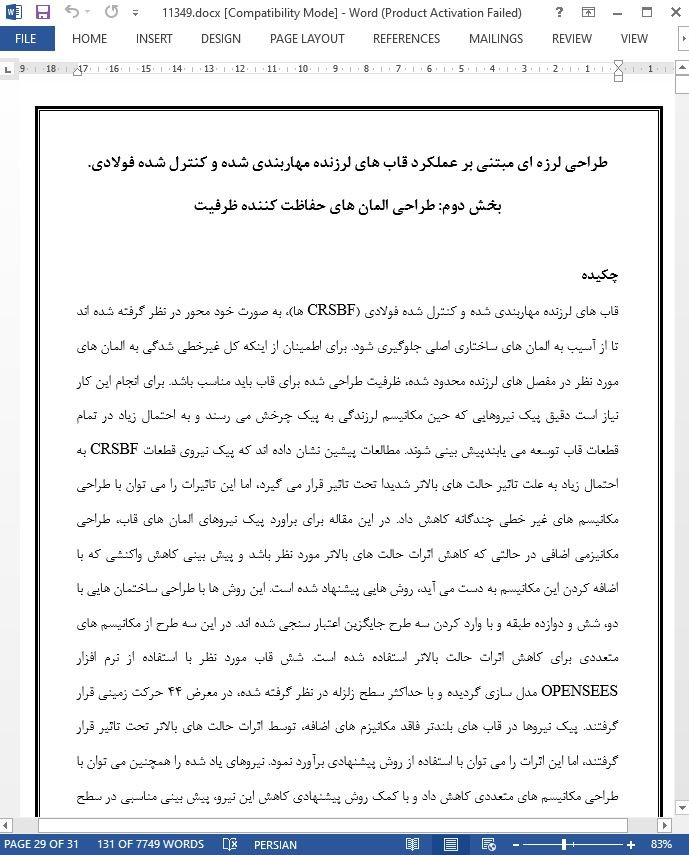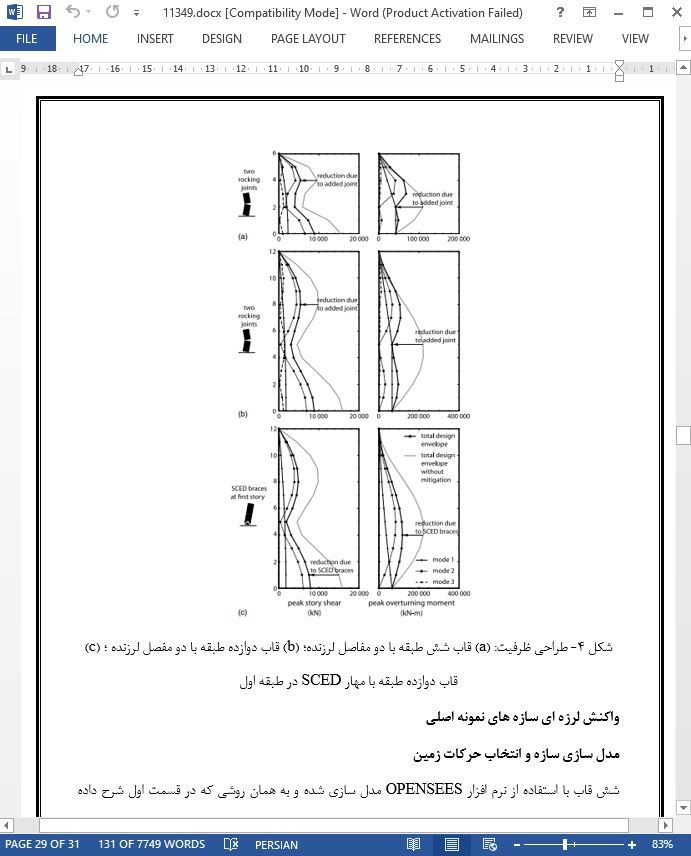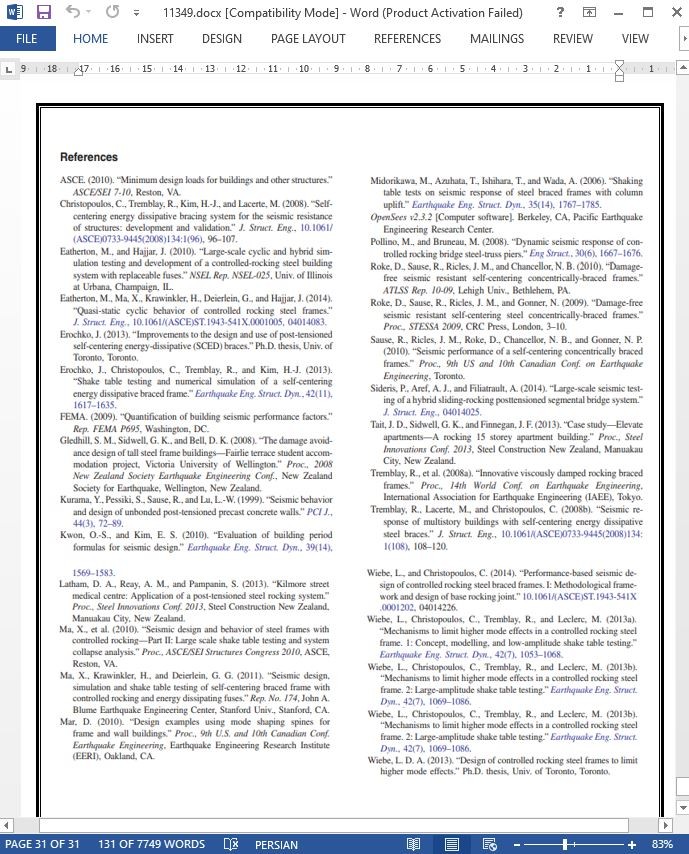
طراحی لرزه ای مبتنی بر عملکرد قاب های لرزنده مهاربندی شده و کنترل شده فولادی
چکیده
قاب های لرزنده مهاربندی شده و کنترل شده فولادی (CRSBF ها)، به صورت خود محور در نظر گرفته شده اند تا از آسیب به المان های ساختاری اصلی جلوگیری شود. برای اطمینان از اینکه کل غیرخطی شدگی به المان های مورد نظر در مفصل های لرزنده محدود شده، ظرفیت طراحی شده برای قاب باید مناسب باشد. برای انجام این کار نیاز است دقیق پیک نیروهایی که حین مکانیسم لرزندگی به پیک چرخش می رسند و به احتمال زیاد در تمام قطعات قاب توسعه می یابندپیش بینی شوند. مطالعات پیشین نشان داده اند که پیک نیروی قطعات CRSBF به احتمال زیاد به علت تاثیر حالت های بالاتر شدیدا تحت تاثیر قرار می گیرد، اما این تاثیرات را می توان با طراحی مکانیسم های غیر خطی چندگانه کاهش داد. در این مقاله برای براورد پیک نیروهای المان های قاب، طراحی مکانیزمی اضافی در حالتی که کاهش اثرات حالت های بالاتر مورد نظر باشد و پیش بینی کاهش واکنشی که با اضافه کردن این مکانیسم به دست می آید، روش هایی پیشنهاد شده است. این روش ها با طراحی ساختمان هایی با دو، شش و دوازده طبقه و با وارد کردن سه طرح جایگزین اعتبار سنجی شده اند. در این سه طرح از مکانیسم های متعددی برای کاهش اثرات حالت بالاتر استفاده شده است. شش قاب مورد نظر با استفاده از نرم افزار OPENSEES مدل سازی گردیده و با حداکثر سطح زلزله در نظر گرفته شده، در معرض 44 حرکت زمینی قرار گرفتند. پیک نیروها در قاب های بلندتر فاقد مکانیزم های اضافه، توسط اثرات حالت های بالاتر تحت تاثیر قرار گرفتند، اما این اثرات را می توان با استفاده از روش پیشنهادی برآورد نمود. نیروهای یاد شده را همچنین می توان با طراحی مکانیسم های متعددی کاهش داد و با کمک روش پیشنهادی کاهش این نیرو، پیش بینی مناسبی در سطح طراحی فراهم می گردد.
مقدمه
بسیاری از سیستم های نیروی مقاومت جانبی در ساختمان ها را می توان از لحاظ اقتصادی به گونه ای طراحی کرد که هنگام زلزله در سطح ایمن طراحی باشند، اما انتظار می رود تعمیر بسیاری از این سیستم ها پس از یک زلزله متوسط یا بزرگ مشکل باشد. بنابراین، برای جلوگیری از آسیب و تغییر شکل باقی مانده، سیستم های خود محور جایگزین، در حال توسعه هستند. یکی از این سیستم ها، قاب های لرزنده مهاربندی شده و کنترل شده فولادی می باشند (CRSBF) که به صورت تجربی مورد مطالعه قرار گرفته (میدوری کاوا و همکاران 2006؛ ترمبلی و همکاران 2008a؛ ما و همکاران 2010؛ ساوس و همکاران 2010؛ ویب و همکاران 2013a، b. ایترتون و همکاران 2014) و در عمل نیز اجرا شده اند (گلدهیل و همکاران 2008؛ مارس 2010؛ لاتام و همکاران 2013؛ تیت و همکاران 2013). در قسمت اول (ویب و کریستوپولوس 2014) چارچوب کلی طراحی CRSBF ها ارائه شده و برای رسیدن به حداکثر واکنش از پیش تعیین شده، روش طراحی مفصل های لرزنده اساس، اعتبار سنجی شده اند. این کار با فرض این که تمام قطعات CRSBF دارای چنان طراحی مناسبی بوده اند که به صورت الاستیک خطی باقی بمانند، انجام شده است.
نتیجه گیری
پیک نیروها در قطعات یک قاب فولادی مهاربندی شده کنترل شده ممکن است تحت تاثیر حالت های بالاتر واکنش لرزه ای باشد. این اثرات به احتمال زیاد و به ویژه برای قاب های های بلند قابل توجه اند، به خصوص اگر چنانکه در قسمت اول توصیه شد (ویب و کریستوپولوس 2014 )، سیستم با یک ضریب بزرگ کاهشی طراحی شده باشد. در مقاله حاضر برای برآورد خواست نیروی الاستیک روی المان های یک CRSBF، از جمله تاثیر حالت های بالاتر، روشی ارائه شد. این روش را می توان در یک صفحه گسترده به راحتی اجرا کرد و می توان آن را برای اهداف طراحی اولیه مورد استفاده قرار داد، زیرا در آن تنها به ویژگی هایی از ساختمان نیاز است که پیش از توسعه طراحی آزمایشی شناخته شده اند.
Abstract
Controlled rocking steel braced frames (CRSBFs) are intended to have a self-centering response that avoids damage to main structural elements. To ensure that all nonlinearity is confined to the intended elements at the rocking joint, the frame must be adequately capacity designed. This requires accurate predictions of the peak forces that are likely to develop in all members of the frame while the rocking mechanism reaches its peak rotation. Previous studies have shown that the peak forces in CRSBF members are likely to be strongly influenced by higher mode effects, but these effects can be mitigated by designing multiple nonlinear mechanisms. This paper proposes methods for estimating the peak forces in frame elements, designing an additional mechanism if it is desired to mitigate higher mode effects, and predicting the reduction in response that will be achieved by adding this mechanism. The methods are validated by designing buildings with two, six, and 12 stories, including three alternative designs that use multiple mechanisms to mitigate the higher mode effects. The six frames are modeled using OpenSees and are subjected to 44 ground motions at the maximum considered earthquake level. The peak forces in the taller frames without additional mechanisms are dominated by higher mode effects, but these effects can be estimated using the proposed method. These forces can also be reduced by designing multiple mechanisms, and the proposed method provides a reasonable design-level prediction of this force reduction.
Introduction
Many lateral force-resisting systems for buildings can be designed economically to provide life safety during a design-level earthquake, but most of these systems are expected to be difficult to repair after a moderate or larger event. Therefore, alternative self-centering systems are being developed to avoid damage and residual deformations. One such system is a controlled rocking steel braced frame (CRSBF), which has been studied experimentally (Midorikawa et al. 2006; Tremblay et al. 2008a; Ma et al. 2010; Sause et al. 2010; Wiebe et al. 2013a, b; Eatherton et al. 2014) and has also been implemented in practice (Gledhill et al. 2008; Mar 2010; Latham et al. 2013; Tait et al. 2013). Part I (Wiebe and Christopoulos 2014) proposes a general framework for the design of CRSBFs and validates a method for designing the base rocking joint to achieve a predetermined maximum response, assuming that all members of the CRSBF were adequately designed to remain linear elastic.
Conclusion
The peak forces in the members of a controlled rocking steel braced frame may be dominated by the higher modes of seismic response. Higher mode effects are likely to be particularly significant for tall frames, especially if the system is designed with a large forcereduction factor, as recommended in Part I (Wiebe and Christopoulos 2014). This paper presented a method to estimate the elastic force demands on the elements of a CRSBF, including the influence of higher mode effects. This method can be implemented in a spreadsheet easily, and it can be used for preliminary design purposes because it requires only building properties that are known before a trial design has been developed.
چکیده
مقدمه
روش برآورد پیک نیروی المان ها
محاسبه لنگر واژگونی اساس در حداکثر چرخش مورد انتظار
کنترل کافی بودن سه حالت برای پوش های طراحی
تعیین شتاب های طیفی حالت های بالاتر
محاسبه برش طبقه و پوش های طراحی لنگر واژگونی
روش اختیاری برای طراحی کاهش حالت بالاتر
طراحی مفصل لرزنده فوقانی
اصلاح پوش های طراحی برای تاثیر بر مفصل لرزنده فوقانی
طراحی مهار (های) غیر خطی
اصلاح پوش های طراحی برای بررسی تاثیر مهار (های) غیر خطی
طراحی عناصر قاب، ابزار های انتقال برش، دیافراگم ها و جمع کننده ها
طراحی سازه های نمونه اصلی
طراحی بدون کاهش حالت بالاتر
طراحی با کاهش حالت های بالاتر
واکنش لرزه ای سازه های نمونه اصلی
مدل سازی سازه و انتخاب حرکات زمین
برش طبقه و نیروهای مهار
لنگر واژگونی و نیروهای ستون
پیک رانش های بین طبقه ای
کشیدگی و بالا آمدگی سرتاسری مهار SCED
جابه جایی باقی مانده
نتیجه گیری
Abstract
Introduction
Method to Estimate Peak Element Forces
Calculation of Base Overturning Moment at Maximum Expected Rotation
Checking whether Three Modes are Adequate for Design Envelopes
Determination of Higher-Mode Spectral Accelerations
Calculation of Story Shear and Overturning Moment Design Envelopes
Optional Method to Design Higher Mode Mitigation
Design of Upper Rocking Joint
Modification of Design Envelopes to Account for Influence of Upper Rocking Joint
Design of Nonlinear Brace(s)
Modification of Design Envelopes to Account for Influence of Nonlinear Brace(s)
Design of Frame Elements, Shear Transfer Devices, Diaphragms, and Collectors
Design of Prototype Structures
Designs without Higher Mode Mitigation
Designs with Higher Mode Mitigation
Seismic Response of Prototype Structures
Modeling of Structure and Selection of Ground Motions
Story Shears and Brace Forces
Overturning Moments and Column Forces
Peak Interstory Drifts
SCED Brace Elongation and Global Uplift
Residual Displacements
Conclusion
- ترجمه فارسی مقاله با فرمت ورد (word) با قابلیت ویرایش، بدون آرم سایت ای ترجمه
- ترجمه فارسی مقاله با فرمت pdf، بدون آرم سایت ای ترجمه



